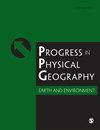Role of Andean tropical montane soil organic carbon in the deglacial carbon budget
IF 3.6
3区 地球科学
Q2 GEOGRAPHY, PHYSICAL
Progress in Physical Geography-Earth and Environment
Pub Date : 2023-04-11
DOI:10.1177/03091333231169431
引用次数: 0
Abstract
During the last deglaciation, atmospheric CO2 increased by about 75 ppm. The deep ocean is likely the dominant source of this atmospheric CO2 rise in the atmospheric pool; however, a consensus accounting for the entire 75 ppm remains elusive. Since the deep ocean cannot account for the entire 75 ppm, the terrestrial environment likely makes up the remainder. This paper provides a mechanism for an unaccounted-for portion of the source of this terrestrial carbon, that being soil organic carbon (SOC) from the tropical montane Andes, and with that, minimum constraints on the contribution of SOC to the total rise in atmospheric CO2 during the last deglaciation. Using numerical climate modeling input into an empirical model derived from tropical montane forests of the Andes Mountains in South America, this study finds that during the last deglaciation, the organic layer thickness was thinning from the Last Glacial Maximum (LGM) to the present (pre-industrial) in the tropical montane Andes. This overall warming and organic layer thickness thinning may have led to a loss of available carbon storage space, causing a leak of CO2 into the atmosphere over this time scale. This study finds an estimate for the contribution of global atmospheric CO2 from SOC in tropical montane Andean soils is likely at least ∼1.4 ppm CO2 since the LGM.安第斯热带山地土壤有机碳在去冰期碳收支中的作用
在最后一次冰川消退期间,大气中的二氧化碳增加了约75ppm。深海很可能是大气中二氧化碳上升的主要来源;然而,关于整个75 PPM的共识仍然难以捉摸。由于深海不能解释整个75百万分之一,陆地环境可能弥补了其余部分。本文为陆地碳来源中尚未解释的部分提供了一种机制,即来自热带山地安第斯山脉的土壤有机碳(SOC),并在此基础上对上一次冰川消融期间大气CO2总上升的贡献进行了最小限制。通过将数值气候模式输入到南美安第斯山脉热带山地森林的经验模型中,研究发现,在末次消冰期间,热带安第斯山脉的有机层厚度从末次盛冰期(LGM)到现在(工业化前)呈减薄趋势。这种整体变暖和有机层厚度变薄可能导致可用碳储存空间的损失,导致二氧化碳在这个时间尺度上泄漏到大气中。该研究发现,自LGM以来,热带山地安第斯土壤中有机碳对全球大气CO2的贡献估计可能至少为~ 1.4 ppm CO2。
本文章由计算机程序翻译,如有差异,请以英文原文为准。
求助全文
约1分钟内获得全文
求助全文
来源期刊
CiteScore
7.20
自引率
5.10%
发文量
53
审稿时长
>12 weeks
期刊介绍:
Progress in Physical Geography is a peer-reviewed, international journal, encompassing an interdisciplinary approach incorporating the latest developments and debates within Physical Geography and interrelated fields across the Earth, Biological and Ecological System Sciences.

 求助内容:
求助内容: 应助结果提醒方式:
应助结果提醒方式:


